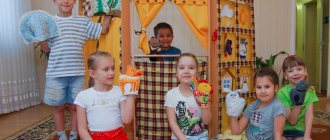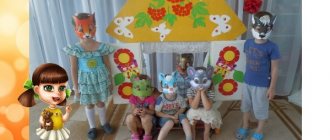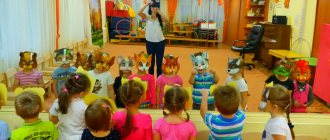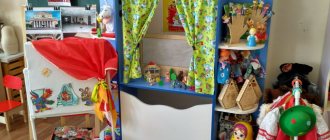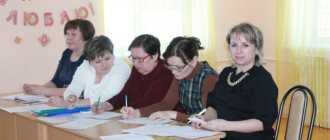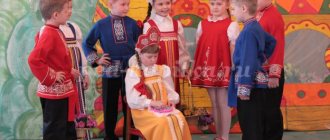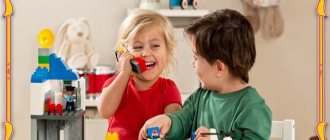Significance of the work
Theatrical activities according to the Federal State Educational Standard in preschool educational institutions help the teacher to raise active and bright personalities. Children learn to see unusual details in the world around them and create artistic images based on them.
Theatrical activities according to the Federal State Educational Standard in preschool educational institutions contribute to the formation of associative thinking in children. By trying themselves in different roles, children overcome shyness and self-doubt, become more relaxed and open to communication with peers.
Peculiarities
Theatrical activities in preschool educational institutions in accordance with the Federal State Educational Standard are aimed at solving the following important issues:
- formation of the correct model of children’s behavior in modern conditions;
- improving the general culture of preschool children, introducing them to spiritual and moral values;
- improving children's speech, activating vocabulary, improving the sound culture of speech, intonation structure, improving dialogue;
- introducing preschoolers to children's music, works of art, rules of behavior at the table (at a party), folk traditions;
- instilling cognitive interest in theatrical art;
- improving emotional experiences, encouraging imaginative thinking.
The use of theatrical scenarios in the classroom helps the teacher develop creative collaboration and public speaking skills in preschoolers.
Theatrical activities in preschool educational institutions in accordance with the Federal State Educational Standard
YULIA ONASHVILI
Theatrical activities in preschool educational institutions in accordance with the Federal State Educational Standard
Theatrical activities in preschool educational institutions in accordance with the Federal State Educational Standard.
Why theatrical activities?
This is one of the most effective ways to influence children, in which the principle of learning is most fully and clearly demonstrated: learn by playing.
It is known that children love to play; they should not be forced to do so. While playing, we communicate with children on “their territory.” By entering the world of play, we can learn a lot ourselves and teach our children. And the words spoken by the German psychologist Karl Gross are relevant in this regard: “We play not because we are children, but childhood itself is given to us so that we can play.”
The founder of the Moscow Puppet Theater S.V. Obraztsov once expressed the idea that every child has a natural desire for acting.
And we know that acquaintance with the theater occurs in an atmosphere of magic, festivity, and high spirits, so it is not difficult to interest children in the theater.
In the context of the transition to the Federal State Educational Standard for Preschool Education, one of the main principles of preschool education reflected in the Standard is:
“Implementation of the Program in forms specific to children of this age group, primarily in the form of play, cognitive and research activities, in the form of creative activity that ensures the artistic and aesthetic development of the child.”
Theatrical activities in kindergarten are an excellent opportunity to reveal the creative potential of a child and foster the creative orientation of the individual.
Using theatrical activities in the system of educating children in preschool educational institutions, we solve a set of interrelated problems in all educational areas according to the Federal State Educational Standard for Preschool Education:
Social and communicative development
• formation of positive relationships between children in the process of joint activities;
• fostering a culture of knowledge in adults and children (emotional states, personal qualities, assessment of actions, etc.);
instilling in the child self-respect and a conscious attitude towards his activities;
• development of emotions;
• education of ethically valuable ways of communication in accordance with the norms and rules of life in society.
Cognitive development
• development of diverse ideas about reality (different types of theater, professions of people creating the performance);
• observation of natural phenomena, animal behavior (to be conveyed by symbolic means in a dramatization game);
• ensuring the relationship between construction and theatrical play for the development of dynamic spatial concepts;
• memory development, learning the ability to plan your actions to achieve results.
Speech development
• promoting the development of monologue and dialogic speech;
• enrichment of the vocabulary: figurative expressions, comparisons, epithets, synonyms, antonyms, etc.;
• mastering expressive means of communication: verbal (regulation of tempo, volume, pronunciation, intonation, etc.) and non-verbal (facial expressions, pantomime, postures, gestures);
Artistic and aesthetic development
• introduction to highly artistic literature, music, folklore;
• development of imagination;
• involvement in joint design activities on modeling costume elements, scenery, attributes;
• creation of an expressive artistic image;
• formation of elementary ideas about types of art;
• implementation of independent creative activities of children.
Physical development
• coordination of actions and accompanying speech;
• the ability to embody the mood, character and process of image development in a creative movement;
• expressiveness of execution of basic types of movements;
• development of general and fine motor skills: coordination of movements, fine motor skills of the hand, relief of muscle tension, formation of correct posture.
System of work for organizing theatrical activities:
1. Subject-spatial development environment
2. Long-term planning and implementation: theater classes, theatrical performances, entertainment, project activities.
3. Interaction with teachers
4. Working with children
5. Interaction with parents
6. Interaction with society
Therefore, when designing a subject-spatial environment that provides theatrical activities for children, we take into account:
• subject-spatial environment is the basis for the independent creativity of each child.
• adherence to the principles of building a developmental gaming environment
• compliance with the age characteristics of children
• compliance with safety regulations
• aesthetic design of gaming equipment
Theatrical activities in kindergarten can be included, in accordance with the Federal State Educational Standard, in educational activities carried out in the process of organizing various types of children's activities (game, communicative, musical and artistic, etc.); educational activities carried out during regime moments; independent activities of children.
The content of work with children on theatrical activities includes:
Diction exercises (articulation gymnastics);
Tasks for the development of speech intonation expressiveness;
Transformation games, imaginative exercises;
Exercises for the development of children's plasticity;
Rhythmic minutes;
Finger play training;
Exercises to develop expressive facial expressions, elements of pantomime;
Theater sketches;
Acting out mini-dialogues, nursery rhymes, songs, poems;
Watching puppet shows.
Basic requirements for organizing theatrical games
• Content and variety of topics.
• Constant, daily inclusion of theatrical games in all forms of the pedagogical process.
• Maximum activity of children during the stages of both preparation and play.
• Cooperation of children with each other and with adults at all stages of organizing a theatrical game.
• The sequence and complexity of the content of the themes and plots chosen for the games correspond to the age and skills of the children.
Interaction with teachers
The effective work of the institution for theatrical activities of children is facilitated by a professional teaching staff.
Work to improve pedagogical skills is carried out in several directions:
• Advanced training as part of course training.
• Improving the qualifications of teachers in theatrical activities within a preschool institution through methodological events and pedagogical advice.
Results of the work of the preschool educational institution:
Children master expressive speech skills, rules of behavior, etiquette for communicating with peers and adults.
Show interest and desire for theatrical art.
They are able to convey various feelings using facial expressions, gestures, and intonation.
They independently perform and convey images of fairy-tale characters.
Children try to feel confident during performances.
The subject-spatial developmental environment of the preschool educational institution was supplemented with different types of theaters, manuals, drawings, and card files of creative games.
Close contact has been established with parents.
When we engage in theater with children, we set ourselves the goal of making our children’s lives interesting and meaningful, filling it with vivid impressions, interesting activities, and the joy of creativity. We strive to ensure that children can use the skills acquired in theatrical activities in everyday life.
From all of the above, we can conclude that we are on the right path and, on the basis of theatrical activities, it is possible to realize almost all the tasks of raising, developing and teaching children.
Main areas of work
Costume play is a phenomenon with deep historical roots. Currently, it has become an independent type of activity characteristic of humans.
Theatrical activities according to the Federal State Educational Standard in preschool educational institutions contribute to solving the following tasks:
- teaching preschoolers spatial orientation skills;
- building a dialogue on a specific topic;
- voluntary tension and relaxation of individual muscle groups;
- memorizing texts (auditory and visual memory);
- observation;
- figurative thinking.
There are several techniques that help instill in preschoolers an interest in the performing arts.
Rhythmoplasty
This element is necessarily included in the program for theatrical activities in the preschool educational institution Federal State Educational Standard. The essence of rhythmoplasty is a set of musical, rhythmic, plastic exercises and games that are designed to develop the natural psychomotor abilities of preschoolers. Thanks to such exercises, theatrical activities within the framework of the Federal State Educational Standard become bright and rich.
Children acquire the skills of expressive body movements and feel harmony with the world around them.
The main goal of introducing rhythmoplasty into preschool educational institutions is to develop the skill of voluntary response to musical sounds and the teacher’s signal. Gradually, children develop coordination of movements, remember certain poses, and learn to convey them using images and facial expressions.
Theatrical activities in kindergarten according to the Federal State Educational Standard article on the topic
Kryazheva Tatyana Anatolevna,
additional education teacher
Municipal budgetary educational institution "Secondary school No. 7 of the city of Nyandoma" branch "Kindergarten No. 2 "Fairy Tale"
Theatrical activities in kindergarten according to the Federal State Educational Standard
“The theater is a magical world. He gives lessons in beauty, morality and ethics. And the richer they are, the more successful the development of the spiritual world of children is…” (B. M. Teplov)
In a preschool educational institution, theatrical activity is one of the most accessible forms of art for children; it gives the child the opportunity to satisfy his any desires and interests, get acquainted with the world around him in all its diversity, and activate the vocabulary and sound culture of speech. Theatrical activities are an inexhaustible source of development of the child’s feelings, experiences and emotional discoveries.
It is known that children love to play; they should not be forced to do so. While playing, we communicate with children on “their territory.” By entering the world of play, we can learn a lot ourselves and teach our children. And the words spoken by the German psychologist Karl Gross are relevant in this regard: “We play not because we are children, but childhood itself is given to us so that we can play.”
We know that getting to know the theater takes place in an atmosphere of magic, festivity, and high spirits, so it is not difficult to interest children in the theater.
In the context of the transition to the Federal State Educational Standard for Preschool Education, one of the main principles of preschool education, reflected in the Standard: “Implementation of the Program in forms specific to children of this age group, primarily in the form of play, cognitive and research activities, in the form of creative activity that ensures artistic and aesthetic child development".
Theatrical activities in kindergarten are an excellent opportunity to reveal the creative potential of a child and foster the creative orientation of the individual.
The content of work with children on theatrical activities in preschool educational institutions is organized as follows
- Diction exercises (articulation gymnastics);
- Tasks for the development of speech intonation expressiveness;
- Transformation games, imaginative exercises;
- Exercises for the development of children's plasticity;
- Rhythmic minutes;
- Finger play training;
- Exercises to develop expressive facial expressions, elements of pantomime;
- Theater sketches;
- Acting out mini-dialogues, nursery rhymes, songs, poems;
- Watching puppet shows.
Starting work on this topic, I studied the literature on theatrical activities of preschool children: tasks, means, methods of work. Using theatrical activities in the system of educating children in preschool educational institutions, I try to solve a set of interrelated problems in all educational areas according to the Federal State Educational Standard for Preschool Education.
Social and communicative development
• formation of positive relationships between children in the process of joint activities;
• fostering a culture of learning in adults and children (emotional states, personal qualities, assessment of actions, etc.);
instilling in the child self-respect and a conscious attitude towards his activities;
• development of emotions;
• education of ethically valuable ways of communication in accordance with the norms and rules of life in society.
Cognitive development
• development of diverse ideas about reality (different types of theater, professions of people creating the performance);
• observation of natural phenomena, animal behavior (to be conveyed by symbolic means in play-dramatization);
• ensuring the relationship between construction and theatrical play for the development of dynamic spatial concepts;
• memory development, learning the ability to plan your actions to achieve results.
Speech development
• promoting the development of monologue and dialogic speech;
• enrichment of the vocabulary: figurative expressions, comparisons, epithets, synonyms, antonyms, etc.;
• mastering expressive means of communication: verbal (control of tempo, volume, pronunciation, intonation, etc.) and non-verbal (facial expressions, pantomime, postures, gestures);
Artistic and aesthetic development
• introduction to highly artistic literature, music, folklore;
• development of imagination;
• involvement in joint design activities on modeling costume elements, scenery, attributes;
• creation of an expressive artistic image;
• formation of elementary ideas about types of art;
• implementation of independent creative activities of children.
Physical development
• coordination of actions and accompanying speech;
• the ability to embody the mood, character and process of image development in a creative movement;
• expressiveness of execution of basic types of movements;
• development of general and fine motor skills: coordination of movements, fine motor skills of the hand, relief of muscle tension, formation of correct posture.
In my work with children, I use various techniques: diction exercises (articulation gymnastics); tasks for the development of speech intonation expressiveness; transformation games, imaginative exercises; exercises for the development of children's plasticity; rhythmic minutes; finger play training; exercises for the development of expressive facial expressions, elements of pantomime; theatrical sketches; acting out mini-dialogues, nursery rhymes, songs, poems; watching puppet shows.
To identify the interests of children in groups, exhibitions of books with fairy tales were held, and a quiz “Visiting a Fairy Tale” was held.
To organize a children's theater, we need puppets of various systems that develop in children certain skills and abilities, stimulate children's creativity (singing, dancing, playing), encouraging improvisation on children's musical instruments. I filled up theater corners in groups. Of all the types of puppet theater in kindergarten, the most popular is the theater of pictures and bi-ba-bo dolls.
In my work I use different types of theater:
- Finger theater – promotes better control of the movements of your own fingers.
- Puppet theater on the table - promotes mastery of the technique of controlling tabletop theater puppets (dolls made of paper cones, cylinders, boxes, toys made of fabric, fur, foam rubber, etc.)
- Spoon theater, riding puppets (bibabo, gapit dolls*) – introducing children to the theater screen and the basics of puppeteering.
- Puppets, dolls with a “living hand”
- People dolls and cane dolls.
Performances were shown for children of younger groups: “Cat’s House”,
“Three Bears”, “Teremok”, “The Fox and the Hare”, performances “Cinderella”, “Spikelet” (based on a Ukrainian folk tale).
Interesting scenarios in verse were complemented by songs of the heroes and colorful dances. The children enthusiastically performed their roles, demonstrated expressive speech and movements, and even successfully improvised during the script. The success of the performance also depended on the parents, many of whom worked hard and sewed wonderful costumes for the children. Both the audience and the actors themselves enjoyed the performance.
Theatrical activities are one of the favorite types of children's activities; theater classes always bring joy to children, they enjoy constant love, but this is not the only reason for their value. Theatrical performances contribute to the formation of expressiveness of speech and movements, form the habit of public speaking, necessary for a modern member of society, and allow the formation of experience in social behavior skills due to the fact that every literary work or fairy tale for children always has a moral orientation (friendship, kindness, honesty, courage and etc.). Thanks to a fairy tale, a child learns about the world not only with his mind, but also with his heart. And he not only knows, but also expresses his own attitude towards good and evil. Theatrical activities allow the child to solve many problematic situations indirectly on behalf of a character. This helps overcome timidity, self-doubt, and shyness. Thus, theatrical activities help to develop the child comprehensively.
The performance of the theater group artists from school 3 was met with applause. The fairy tale “The Swineherd” by Hans Christian Andersen was performed expressively with childlike spontaneity. The young spectators were very pleased and thanked the artists with applause.
The theatrical game “Circus of Animals”, excursions to the library, and the Center for Culture and Sports “Theater and the Profession in It” caused a positive emotional response among children of older groups. Children are looking forward to performances by the puppet theater from the city of Velsk.
Artists always bring interesting and instructive tales. The meeting with the Nyandoma poetess N.A. Teplukhina aroused great interest; she spoke about her theatrical activities.
Participating in holidays as a host, in the role of a fairy-tale character, I try to show children by my own example how interesting reincarnation is.
Preschool education involves the interaction of all participants in the educational process: children, teachers, parents. Recognition of the priority of family education requires relations between family and educational institutions that are determined by cooperation and trust.
In my work on theatrical activities, I actively involve parents and other family members of students, as I consider this cooperation necessary and effective in the upbringing and education of children.
Parents take an active part in creating a developmental environment for their children. Having set myself the task of getting parents interested in creating a developing theatrical environment, I offer them help in sewing costumes for children and adults, making various attributes, hats, and scenery.
I introduce parents to different types of theaters, tell them what they can be made from and how they can be made for kindergarten and for home at consultations and moving screens (“What is theater”, “First steps to the stage”). Parents actively help in everything, thanks to which each group and music room has everything necessary for theatrical activities.
In almost every event (be it a holiday, leisure or entertainment), the roles of some characters are played by parents or children of older groups. We practice staging performances both with adults and together with children. Preparing for performances is always fun and emotional. This brings us together, parents and teachers are full of optimism and interest, children get tremendous pleasure from the process. Watching such productions and participating in them gives children the opportunity to fully adopt the experience of adults. This makes it possible to more effectively solve the assigned pedagogical tasks, develop the artistic and aesthetic taste and creative abilities of children, and also maintain the relationship between the kindergarten and parents in the common cause of upbringing, education and development of the child.
Results of my work:
Children master expressive speech skills, rules of behavior, etiquette for communicating with peers and adults.
Show interest and desire for theatrical art.
They are able to convey various feelings using facial expressions, gestures, and intonation.
They independently perform and convey images of fairy-tale characters.
Children try to feel confident during performances.
The subject-spatial developmental environment of the preschool educational institution was supplemented with different types of theaters, manuals, drawings, and card files of creative games.
Close contact has been established with parents.
When I engage in theater with children, I set myself the goal of making our children’s lives interesting and meaningful, filling it with vivid impressions, interesting activities, and the joy of creativity. I strive to ensure that children can use the skills acquired in theatrical activities in everyday life.
Culture and technique of speech
These elements must be included by the teacher in his plan. Theatrical activities in preschool educational institutions in accordance with the Federal State Educational Standard are aimed specifically at the development of correct articulation and speech breathing. Children acquire clear diction, learn to independently compose short fairy tales and stories, select poetic rhymes, pronounce tongue twisters, and read poetry with intonation. Involving preschoolers in theatrical activities helps to replenish their vocabulary and improve their communication skills.
An analysis of theatrical activities in preschool educational institutions according to the Federal State Educational Standard involves a comparison of initial skills and abilities with those that a child acquires (develops) with the help of art.
Relevance, purpose and objectives of theatrical activities in preschool education.
Theatrical activity is a source of development of feelings, deep experiences of the child, and introduces him to spiritual values. It is equally important that theatrical games develop the emotional sphere and make one sympathize with the characters. Theatrical activities permeate all routine and educational moments.
The basis of this work lies in the use of nursery rhymes, sayings, jokes, and lullabies. Oral folk art, presented in the form of skits and dramatization games, creates an atmosphere of warmth, kindness, attention, and contributes to the formation of an emotionally positive attitude of children to the world around them and their cognitive development.
Theatrical activities develop the child’s personality, instill a sustainable interest in literature and theater, improve children’s artistic skills in terms of experiencing and embodying an image, and encourage them to create new images.
Thanks to this form of work, communication with children becomes more interesting and meaningful. It is no secret that young children perceive speech addressed to them better if it is supported by visual objects (pictures, toys).
During development, changes occur in the emotional sphere of the child. His views on the world and relationships with others change. The child's ability to recognize and control his emotions increases. But the emotional sphere itself does not develop qualitatively. It needs to be developed.
Being confined to televisions and computers, children began to communicate less with adults and peers, but communication greatly enriches the sensory sphere. Children today have become less responsive to the feelings of others
Theatrical activities in kindergarten can organizationally permeate all routine moments: be included in all classes, in the joint activities of children and adults in their free time, and carried out in children’s independent activities. Theatrical activities can be organically included in the work of various studios and clubs; products of theatrical activities (stage plays, dramatizations, performances, concerts, etc.) can be included in the content of holidays and entertainment.
Thus, theatrical activity is the most important means of developing in children the ability to recognize a person’s emotional state by facial expressions, gestures, intonation, the ability to put oneself in his place in various situations, and find adequate ways to help. Theatrical activities make it possible to develop the experience of social behavioral skills due to the fact that every literary work or fairy tale for preschool children always has a moral orientation (friendship, kindness, honesty, courage, and others). Theatrical activities are a source of development of feelings, deep experiences and discoveries of the child, introducing him to spiritual values. Theater reveals the spiritual and creative potential of the child and provides a real opportunity to adapt to the social environment.
